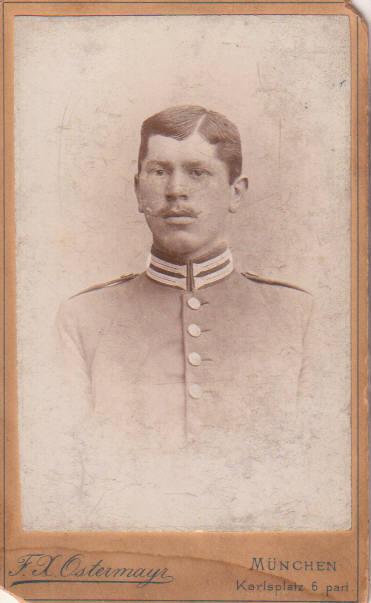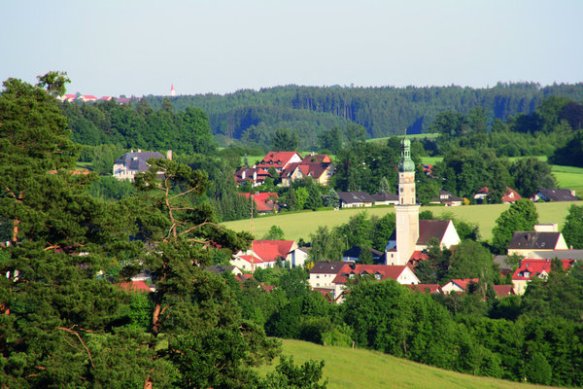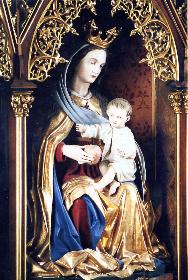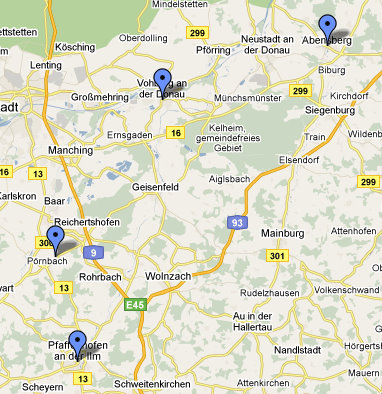
Hilaury – left approx. age 9 in Regensburg, middle approx. age 20-23 in Amberg, right approx. age 25-30 in Philadelphia
The theme for Week 7 of the 2015 edition of the “52 Ancestors in 52 Weeks” challenge is “Love” and my choice is a relative, but not an ancestor – my great-aunt, Hilaury Bergmeister Thumann. Baptized Hilaria, she was called Hilaury, or Lari for short, and Laura once she moved to America. I had to depart from the direct line of ancestors for this one, because the theme asked “Which ancestor do you love to research? Which ancestor do you feel especially close to? Which ancestor seemed to have a lot of love?” The answer to all three of those questions is great-aunt Laura because she continues to surprise me, I’ve found ancestors and relatives directly as a result of researching her (as opposed to her brother, my direct ancestor), and I feel like we share some things in common.
Laura’s Story
Much of Laura’s story might be familiar if you’re following along with these weekly posts – her brother, my great-grandfather Joseph Bergmeister, was profiled in Week 5. I’ve also written about Laura on the blog before, but since then I’ve discovered a few more things about my favorite great-aunt.
Laura Bergmeister was born on 10 January 1870 in Asbach, Bavaria, Germany to Joseph Bergmeister and Ursula Dallmaier. She was born illegitimate, but her father was named in the baptismal document and the couple married the following year on 11 April 1871 in Pfaffenhofen an der Ilm. Joseph was a flour merchant, the son of a long line of millers in the town of Puch. Since Joseph was not the oldest son who would inherit the mill, he was a merchant of the mill’s goods. His children are born in various towns throughout Bavaria, so I assume he traveled from town to town selling flour. Ursula was the daughter of an innkeeper in the town of Asbach, and that is where Laura was born. In 1871 the family was living in Vohburg a.d. Donau when a daughter named Marie was born on 17 November, but the baby did not survive. In 1873, Joseph was born in Vohburg. In 1873, Ignatz was born in Abensberg.
By 1879, the family appears to be living in Regensburg based on a photograph of Laura, her brothers, and their mother. Laura made her First Communion at the Dom St. Peter, the cathedral of Regensburg, in May, 1880.
At some point during Laura’s childhood, her father died. I have yet to find out when, but it was sometime after the youngest son’s birth 1876 and 1884, because in May of 1885 his widow is remarried and having another child. By 1884, mother Ursula is married to Herman Goetz (Götz). The Bergmeister siblings gained half-brothers Herman in 1885 and Julius in 1886 as well as a half-sister Elsa (birth date not yet known).
Often in discovering information about our ancestors and relatives through genealogical documents, we only uncover bare facts such as names or dates or places. However, I was given a couple of unique family heirlooms/ephemera that belonged to Laura that actually gave me some insight into her personality.
One is an “autograph” book, also called a stammbuch or poesiealbum (poetry album). The concept began in Germany among university students – almost like a yearbook by today’s standards, minus photographs – in which students would have friends and professors write a page, usually a poem, to the owner. By the late 19th Century – when Laura was a girl – the books were popular among teenage girls.
The very first entry in her book is signed by “father” on 24 October 1883 – I just can’t be certain (yet) that it is her father Joseph or instead her step-father Herman. The next page is signed by her mother, but not until 01 April 1884 and there are some entries later in the book that are dated in between those two. The book itself will result in a series of posts here once I get all of the entries translated, but in the ones I have so far it seems, based on the poems, that Laura had a cheerful spirit and spread that good cheer among others.
She started this book when she was 13 years old and entries include her parents, brother(s), cousins, and girlfriends. She collects a few entries each year all the way until she’s almost 26 years old for a total of 35 pages of poems or notes. Incredibly, she even has a few entries from people she met on the ship to America!
In July, 1893, 23-year-old Laura made her way to Antwerp, Belgium and boarded the SS Friesland. It arrived in New York on July 25th. It always intrigued me that she came, presumably alone, to America at a relatively young age for a woman to be traveling alone. She had no family in this country except for some rather distant cousins in Philadelphia – so distant that it’s unlikely they knew they were related. After seeing the autograph book, however, I realized Laura didn’t make the journey all alone – she had at least one girlfriend with her. One of the entries is in perfect English and reads:
In fourteen hundred and ninety two, Columbus sailed the ocean blue. In eighteen hundred and ninety three, together we sailed you and me. From your loving friend, Wally Kuchenreuter

Wally Kuchenreuter’s entry in Hilaury’s autograph book circa July 1893
Sure enough, Wally, presumably short for Walburga, is listed on the passenger list immediately above Laura. She is 18 and listed as a servant. I found her in the 1900 census working as a maid in the household of a prominent Philadelphia lawyer. When I looked over the passenger list more closely, I noticed that there are several single woman aged 18 to 24 that are listed as “servant” – in Laura’s case, she is listed as “housekeeper”. Did they all come together for work? A couple of these young girls signed Laura’s autograph book on the way over, and there was even an entry from Louis Lester Rosenbaum who apparently was an engineer for Edison Electric Light. This tells me that young Laura wasn’t a shy girl if she has men signing her autograph book on board the ship!
Laura (and Wally, for that matter) settled in Philadelphia. I don’t know anything about Laura’s life until three years later. On 15 June 1896, she married Max Thumann, a cabinetmaker originally from Regensburg, who was 13 years her senior. They come from the same city, but Max had been in the United States since 1883. If they knew each other in Germany, Laura would have only been 13 years old when he left!

Max and Laura at their home, September 1910
At the time of Laura and Max’s marriage, she lived at 2827 Reese Street in Philadelphia. By 1900, the couple was living at 1033 Jefferson Street and Hilaire’s occupation is listed as “retail grocery”. Interestingly, one of the witnesses to Max and Hilaire’s marriage, Michael Hoffbauer, is a grocer at Hilaire’s old Reese Street address, so it is presumed that she continued to work there. Max and Hilaire bought a house at 6078 Kingsessing Avenue in 1907, and they lived there until their deaths.
Beginning in 1900, Max and Laura welcomed the arrival of the first of Laura’s brothers from Bavaria. When she left Germany, her Bergmeister brothers were 20 and 17, and her Goetz brothers were still children aged 8 and 7. I only recently found out about sister Elsa, presumable a half-sister, but I don’t know where she falls into the family. Despite their ages and the distance between them, communication must have continued through letters across the ocean. Because when each brother arrived in the US, their passenger list shows they were going to Hilaire and Max’s house and that the passage was paid for by their brother-in-law Max Thuman.
Joseph was the first brother to join Laura in America, arriving in New York City in May, 1900. Max paid for his passage, and his sister is listed on the passenger list as the relative who would meet him. Joseph stayed with the Thumann’s until he could find work and rent a house, and he is enumerated with them on the 1900 Census.
Next to arrive was 16-year-old half-brother, Julius Goetz, in September 1902. He is recorded as a locksmith from Regensburg going to his brother-in-law Max Thumann. Julius also lived with the Thumann’s until he found work in a factory and a place to live. He later returns to live with them after his 1919 marriage for a brief time.
In 1904, Ignatz Bergmeister arrives in New York City in June. His passage was also paid for by Max, and the list annotates that he was “met by sister at the landing”. It is not certain if Ignatz lived in Philadelphia for a time or if he stayed in New York City. He marries in New York in 1907 and is living there in 1910, but since Hilaire met him in New York it is possible that he also came to stay with the Thumann’s in Philadelphia for a short time.
The last brother, Herman Goetz, came to America in 1911 (after the death of their mother) at the age of 26. His passenger arrival record lists his brother Julius as his next of kin in America, but he lived with the Thumann’s for several years, including at the time of his marriage in 1913.
The Thumann’s were definitely involved with Joseph Bergmeister’s family. Joseph’s first son and first American-born child was also named Joseph, born in 1902. For his baptism, Uncle Max and Aunt Laura were his godparents. In 1905, Max was born, and the couple was once again godparents. In 1907, Julius had Aunt Laura as his godmother and his namesake Uncle Julius as his godfather. Two babies died shortly after birth in 1909 and 1911, including a daughter named Laura after her aunt. Joseph’s youngest child was Margaret, my grandmother, born in 1913. Aunt Laura again takes her place as godmother, and her godfather was Uncle Herman which explains Margaret’s unusual middle name, Hermina.
Laura was also involved as an aunt with her brother Ignatz’s children even though they lived farther away in Elizabeth, NJ. Ten-year-old niece Teresa wrote to her aunt in 1919 thanking her for the “beautiful things” she sent.

Laura (center) having some fun with family. The woman on the right is sister-in-law Teresa. The boy is Charles, son of Teresa and Ignatz (Laura’s nephew). The girl may be his sister Teresa but appears too young. The woman on the left is unidentified but looks strikingly like my grandmother, which leads me to believe it is my great-grandmother Marie, Laura’s sister-in-law. Approximate date: 1915-1917. Approximate place: Elizabeth, NJ
When my grandmother died, I found a “calling card” of Laura’s which tells me she was a sociable woman with a lot of friends. In addition to the wonderful autograph book, my cousin gave me Laura’s scrapbook containing a lot of postcards from family and friends (an entire series of cards from her husband’s friend Ferdinand is featured in an ongoing series of posts here). Some of the postcards were from her brother Herman before he immigrated, at least one is from the previously unknown sister Elsa, and some appear to be from a niece that is either the daughter of Elsa or a niece of husband Max. All of these things point out to me that Laura cared about friends and family and made the effort to keep in touch. Many of the cards thank her for either a letter, card, or package that she sent them.
In my post about Joseph Bergmeister, I highlighted the tragic events that befell Laura’s family members so I will merely summarize here:
- 1914 Herman’s wife dies during childbirth
- 11 October 1918, Herman Goetz died of pneumonia at the age of 32
- 05 February 1919, Joseph’s wife Maria died from heart disease just weeks weeks away from her 44th birthday
- 19 November 1919, Ignatz died of cirrhosis of the liver at the age of 43
- 30 May 1927, Joseph died of nephritis at the age of 54
- 16 November 1939, Ignatz’s wife Teresa died at the age of 59
Fortunately for Laura, her youngest brother Julius lived a long life so she was able to keep the family connection to him as well as her nieces and nephews for the rest of her life.
Max Thuman died on 26 November 1941 at the age of 84 from pneumonia. Laura only lived for another fourteen months, dying on 6 February 1943 from cancer. She was 73 years old. They are buried together at Mount Moriah Cemetery, which is located just across the street from their home on Kingsessing Avenue.
On the surface, what would I possibly find in common with this woman? I didn’t leave home at a young age to move to a new country. Nor did I marry. I’m probably not as outgoing as Laura seems to be (at least until you get to know me or vice versa). But there is something about her that makes me feel a kinship. Even though she didn’t travel (that I know of) once she moved here, Laura’s trip to this country reminds me of my own love of travel. I didn’t get married (yet) like she did, but I’ve dated older men with an age difference like she had with Max. I try to keep relationships with friends and family over distance. I have a collection of postcards from friends and family. And the most significant commonality – I love my nieces and nephews as she did hers.
The theme this week asks “Which ancestor do you love to research? Which ancestor do you feel especially close to? Which ancestor seemed to have a lot of love?” I love researching Laura because she continues to surprise me with facts about her and her family that I didn’t know. I feel especially close to her – she had no direct descendants and neither do I, so if I don’t remember her amazing life, who will? Finally, she seemed to have a lot of love for her family and friends. I hope that I can be as fun-loving, caring, and thoughtful as she was!
Just the Facts
- Name: Hilaury (Laura) Bergmeister Thumann
- Ahnentafel: N/A – great-aunt, sister of #10 my great-grandfather
- Parents: Joseph Bergmeister (1843-?) and Ursula Dallmaier (1846-1911)
- Born: 10 January 1870 in Asbach, Bavaria, Germany
- Siblings: Maria (1871-1871), Joseph Bergmeister (1873-1927), Ignatz Bergmeister (1876-1919), Herman Goetz (1885-1918), Julius Goetz (1886-1971), Elsa ?
- Married: Max Thumann (1867-1941) on 15 June 1896 in Philadelphia, PA, USA
- Immigrated: departed Antwerp aboard the SS Friesland; arrived in New York City on 25 July 1893
- Children: None. At least 4 nephews and 5 nieces
- Died: 06 February 1943 in Philadelphia, PA
- Buried: Mount Moriah Cemetery, Philadelphia, PA

Written for the 52 Ancestors in 52 Weeks: 2015 Edition– Week 7: Love
#52Ancestors































 Genealogists are eagerly awaiting the release of the 1940 U.S. Federal Census in April 2012 so we can track down the information on all of our relatives. While Ancestry will have the images available for free, they will probably not be indexed for some time. For me, this isn’t necessarily a bad thing…my family’s track record for being recorded and indexed correctly is 5 out of 19 attempts from 1900 through 1930. Of the 14 entries that have incorrect spellings, 8 could be found via Soundex. That left 6 families that had to be found using other search methods. These 19 only include the surnames of my four grandparents – if I added in siblings of great-grandparents and grandparents with different surnames, the error count would be even higher. Here’s a look at how my family’s names fared in census indexing so far:
Genealogists are eagerly awaiting the release of the 1940 U.S. Federal Census in April 2012 so we can track down the information on all of our relatives. While Ancestry will have the images available for free, they will probably not be indexed for some time. For me, this isn’t necessarily a bad thing…my family’s track record for being recorded and indexed correctly is 5 out of 19 attempts from 1900 through 1930. Of the 14 entries that have incorrect spellings, 8 could be found via Soundex. That left 6 families that had to be found using other search methods. These 19 only include the surnames of my four grandparents – if I added in siblings of great-grandparents and grandparents with different surnames, the error count would be even higher. Here’s a look at how my family’s names fared in census indexing so far:




